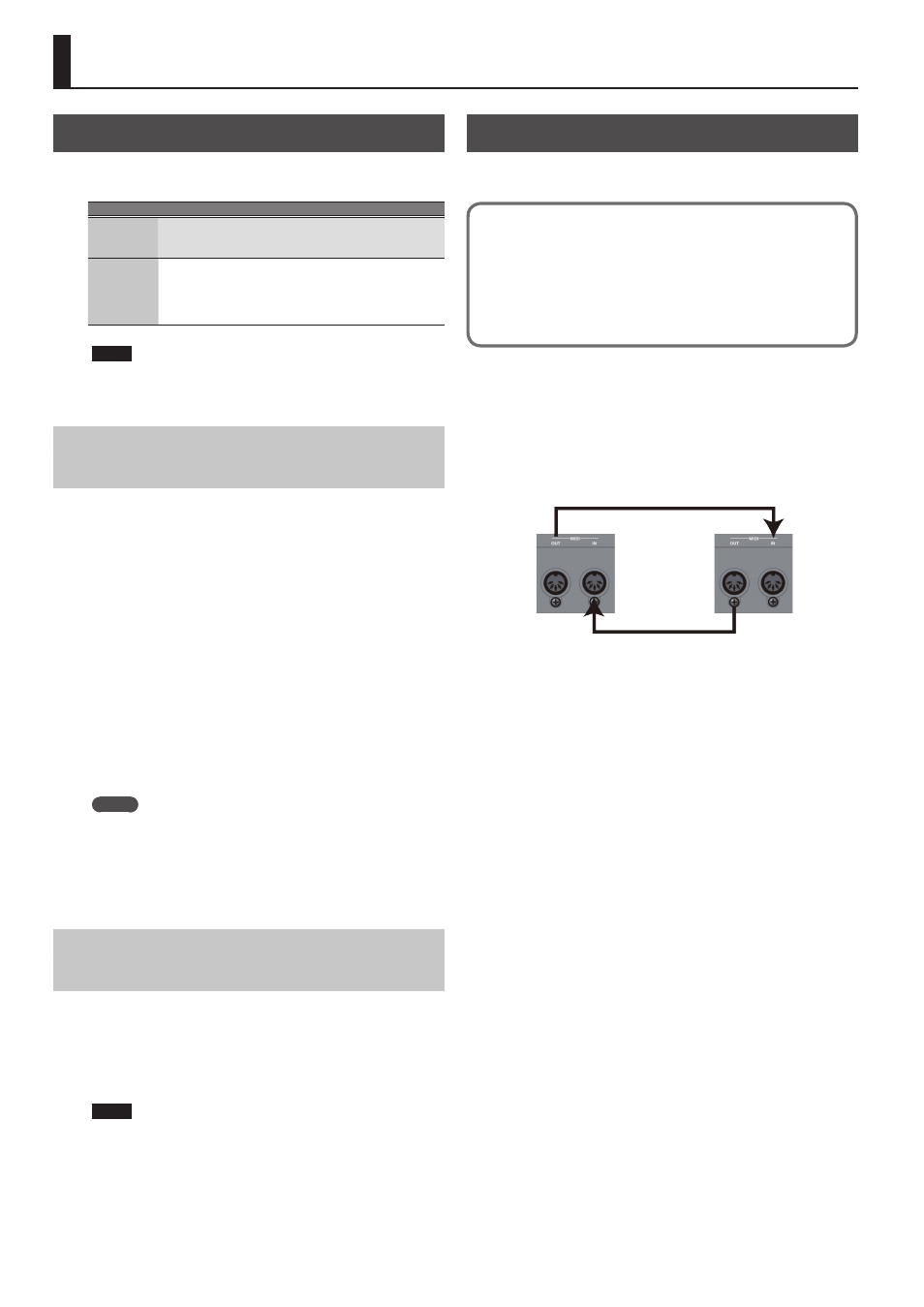Connecting your equipment, Connecting external audio equipment, Connecting midi equipment – Roland E-A7 61 Key Expandable Arranger Keyboard User Manual
Page 10: The input jacks, What is midi, Connection example, Midi channels

10
Connecting Your Equipment
Connecting External Audio Equipment
The E-A7 is equipped with two types of input jack: the INPUT jacks
and the EXT IN jack. Use whichever is suitable for your needs.
Jack
Explanation
INPUT jacks
Effects such as reverb can be applied to the audio input.
Use this jack if you want to sing along with your performance,
or record a sample.
EXT IN jack
The audio input of this jack is output without change from
the OUTPUT jacks or the speakers. It is not possible to apply
effects or adjust the volume.
Use this jack if you want to perform while playing back an
audio player.
NOTE
To prevent malfunction and equipment failure, always turn
down the volume, and turn off all the units before making any
connections.
Connecting a Microphone or External Audio
Device to the INPUT Jacks
Connect your microphone or device (e.g., synthesizer) to the INPUT
jacks.
You can sample the audio from these external audio inputs.
1.
Turn the
[Mic/Line In]
knob all the way to the left,
minimizing the volume.
2.
Connect your microphone or the outputs of your audio
device (e.g., synthesizer) to the E-A7’s INPUT jacks.
3.
Set the INPUT-MIC select switch to MIC if connecting a
microphone, or to LINE if connecting a synthesizer or
other audio device.
4.
Press the
[Input On]
button to make it light; the input
turns on.
5.
Turn the
[Mic/Line In]
knob to adjust the input level.
6.
If you want to apply an effect such as reverb to the
audio input, press the
[Input EFX]
button to turn Input
EFX on.
MEMO
5
If you long-press the
[Input EFX]
button, the Input EFX screen
appears, allowing you to make settings for Input EFX.
For more about the input effects, refer to
“Reference Manual”
(PDF).
5
If you connect a mic, connect it to the L/MONO, MIC jack.
Condenser microphones are not supported.
Connecting an External Audio Device to the EXT
IN Jack
You can connect an audio player or similar device to the EXT IN jack.
1.
Minimize the volume of your external audio device.
2.
Connect your audio player to the E-A7’s EXT IN jack.
3.
Adjust the volume using the controls of the connected
audio device.
NOTE
5
The sound that’s input from this jack cannot be sampled.
5
Noise may occur if you connect or disconnect a cable at the
EXT IN jack while the E-A7 is powered-on, but this is not a
malfunction.
Connecting MIDI Equipment
If MIDI equipment is connected, it can exchange performance
information with the E-A7.
What is MIDI?
MIDI, short for
“Musical Instrument Digital Interface,”
was developed
as a universal standard for the exchange of performance data among
electronic musical instruments and computers.
The E-A7 is equipped with MIDI connectors to let it exchange
performance data with external devices. These connectors can be used to
connect the unit to an external device for even greater versatility.
Connection example
If you use a MIDI cable to connect the E-A7’s MIDI OUT connector to
the MIDI IN connector of your external MIDI device, you’ll be able to
produce sound on your external MIDI device by playing the E-A7’s
keyboard. As necessary, set the receive channel of your external MIDI
device to match the E-A7’s transmit channel.
E-A7
MIDI sound module /
sequencer
The MIDI sequencer plays the sounds of the E-A7.
Use the E-A7 to play the MIDI sound module.
MIDI channels
MIDI uses sixteen channels: 1–16. Even if two MIDI devices are
connected, they won’t be able to select or play each other’s sounds if
the two devices are set to different MIDI channels.
The E-A7 can receive all channels 1 through 16.
&
For details on MIDI settings, refer to
“Reference Manual
(English)”
(PDF).
